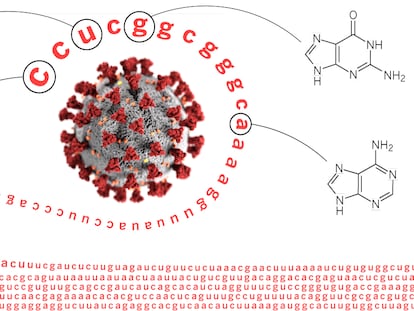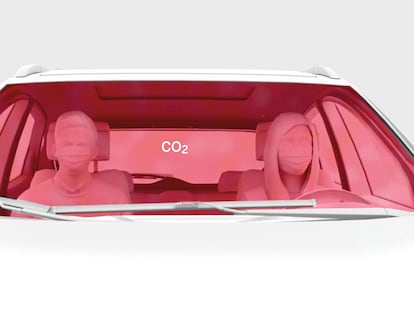EL PAÍS visual feature on aerosol spread of coronavirus wins Kavli Science Award, the ‘Pulitzer’ of scientific journalism
The authors of the article, Mariano Zafra and Javier Salas, are the first Spaniards to receive the prestigious prize

The most-visited content in the history of the EL PAÍS website, a multimedia special headlined “A room, a bar and a classroom: how the coronavirus is spread through the air,” has won another prestigious award: the international AAAS Kavli Science Journalism Awards, considered the Pulitzer of scientific journalism. The feature article has already picked up one of Spain’s Ortega y Gasset awards and the Malofiej prize, the latter considered to be the most relevant for infographics. The Kavli award, meanwhile, is handed out by the association that publishes the prestigious Science magazine.
The recognition is part of the program of scientific journalism prizes from the American Association for the Advancement of Science (AAAS), which have been awarded since 1945 to US media outlets. From 2009, the awards have been opened out to the rest of the world, since the Kavli Foundation started financing them, and this is the first time that a Spanish publication has taken the prize: specifically, the Gold Award in the category of Science Reporting – Large Outlet.
The jury valued the feature article for “examining the risks of the SARS-CoV-2 virus that causes COVID-19 at a time when understanding of the aerosol spread of the disease was still developing.”
“The story had a huge impact,” said judge Laura Helmuth, editor in chief of Scientific American. “It circulated on social media faster and more infectiously than SARS-CoV-2 in a stuffy classroom. People who were too confused or scared or angry to comprehend other stories saw this one and… got it. It’s one of the most effective pieces of journalism I’ve ever seen.”
Its authors, the editor of Visual Narratives at EL PAÍS, Mariano Zafra, and reporter from the Materia science section at the newspaper, Javier Salas, could not be more proud – not just for the recognition, but also for the acknowledgment of the impact. The article has been seen more than 20 million times, has been translated from Spanish to six different languages, and has crossed borders thanks to its concise and visual way of explaining how the coronavirus is transmitted via aerosols. Understanding how the virus behaves in different scenarios has been an antidote for many people and the best example of how good information can save lives.
The history of the article stretches back to October 2020, one of the toughest periods of the coronavirus pandemic. Disinformation, noise and fake news were part of everyday life, and a newspaper can only help this situation by rigorous reporting. According to the director of the Materia section, Patricia Fernández de Lis, the pandemic has likely been the most complicated period of her entire professional career. Scientific journalism has always been important to explain reality, but at times like these, it becomes even more important.
It’s one of the most effective pieces of journalism I’ve ever seenLaura Helmuth, awards judge
Mariano Zafra felt at the time that there was something that was not fully understood. How could the spread of aerosols be explained in a visual format? The publication of a column by the scientist José Luis Jiménez, a chemistry professor at the University of Colorado, gave him the idea. “As I was reading it I was imagining what to do. The only thing that was missing was the parameters, the data on which we could build these scenarios. What size are the aerosols, how much time is needed for an infection, how many contagious aerosols a person emits when speaking or shouting, and so on. The column stated that the scientists had developed a model. And I resorted to that model.”
Zafra began to work on it with Javier Salas and with Jiménez via videoconferencing in order to achieve the required scientific precision. They established the three scenarios of the article in a simple and easy to understand manner: a room, a bar and a classroom, three common places for any citizen.
“For them to give us a prize of this relevance in the scientific sector makes me very proud,” explains Zafra, who created the New Narratives section of EL PAÍS two years ago. “It means that the working model that we are developing in the newspaper is working very well, for a visual journalist to team up with a scientific journalist and work together.”
Meanwhile, Javier Salas explains that he had been working on similar issues with Zafra for some time, and that in a way, they swapped roles. “Mariano became a scientific journalist thanks to everything he researched and read,” he explains. “I was in charge of ordering the visual information properly and the narrative coherence. The most relevant thing in the success of this story is teamwork. We worked for two intense weeks on this, thanks to the efforts of our colleagues, and the work that the Video and Social Networks teams did was decisive, the latter spreading the work in an ordered and rapid manner. We hit all the right keys, because for some months the machinery between Materia and Visual Narratives was well greased and worked very well.”
For them to give us a prize of this relevance in the scientific sector makes me very proudMariano Zafra, editor of Visual Narratives
They soon saw the impact of the special feature. Salas explains that not a single week went by without some institution or media outlet writing to him to request permission to use and to share it. As such, EL PAÍS made it available to all media outlets, allowing it to be published on and adapted to any website.
It became clear that the article had crossed the pond when it was shared by NBA basketball player Manu Ginobili. Newspapers such as The Guardian referenced the story, it was shared on Twitter by the then-Science Minister Pedro Duque, and even the Spanish satirical website El Mundo Today produced a spoof version.
For the director of Materia, Patricia Fernández de Lis, the prize is just the proof, in some way, of the triumph of science and the importance of scientific journalism. “It’s the confirmation that we are doing a relevant and quality job,” she says. “This work, in particular, is very important because it indicates a route where classic journalism and visual narratives can meet.”
Dealing with scientific journalism in the simplest and most understandable manner is something that has characterized the science section at EL PAÍS since its inception, but for Fernández de Lis, counting on a team such as that of New Narratives completely changes the way of collaborating between the sections. “Visual narration means an explosion of new possibilities and it’s perfect for science journalism, to explain how things happen. Scientific journalism has often been confined to the corners of media outlets, to supplements or to parallel sections, but this pandemic, like with the volcano on La Palma, confirms that, in reality, science is an essential part of reality and as such scientific journalism should also be an essential part of a newspaper.”
Tu suscripción se está usando en otro dispositivo
¿Quieres añadir otro usuario a tu suscripción?
Si continúas leyendo en este dispositivo, no se podrá leer en el otro.
FlechaTu suscripción se está usando en otro dispositivo y solo puedes acceder a EL PAÍS desde un dispositivo a la vez.
Si quieres compartir tu cuenta, cambia tu suscripción a la modalidad Premium, así podrás añadir otro usuario. Cada uno accederá con su propia cuenta de email, lo que os permitirá personalizar vuestra experiencia en EL PAÍS.
¿Tienes una suscripción de empresa? Accede aquí para contratar más cuentas.
En el caso de no saber quién está usando tu cuenta, te recomendamos cambiar tu contraseña aquí.
Si decides continuar compartiendo tu cuenta, este mensaje se mostrará en tu dispositivo y en el de la otra persona que está usando tu cuenta de forma indefinida, afectando a tu experiencia de lectura. Puedes consultar aquí los términos y condiciones de la suscripción digital.
More information
Últimas noticias
Most viewed
- Sinaloa Cartel war is taking its toll on Los Chapitos
- Reinhard Genzel, Nobel laureate in physics: ‘One-minute videos will never give you the truth’
- Oona Chaplin: ‘I told James Cameron that I was living in a treehouse and starting a permaculture project with a friend’
- Why the price of coffee has skyrocketed: from Brazilian plantations to specialty coffee houses
- David King, chemist: ‘There are scientists studying how to cool the planet; nobody should stop these experiments from happening’










































